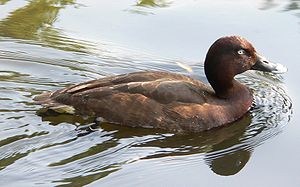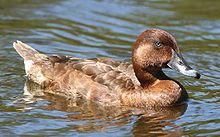Australian bog duck
| Australian bog duck | ||||||||||||
|---|---|---|---|---|---|---|---|---|---|---|---|---|

Australian bog duck ( Aytha australis ) |
||||||||||||
| Systematics | ||||||||||||
|
||||||||||||
| Scientific name | ||||||||||||
| Aythya australis | ||||||||||||
| ( Eyton , 1838) |
The Australian bog duck ( Aythya australis ) is the only diving duck in Australia . It occurs all over the Australian continent. However , it is rarely seen in Tasmania . In its plumage it is reminiscent of the European bog duck . However, it is slightly larger and the plumage is less uniformly brown.
The IUCN classifies the Australian bog duck as not endangered ( least concern ). The population is estimated at 100,000 to 1 million sexually mature individuals. In Australia this species is one of the game birds .
features
Appearance of fully grown Australian bog ducks
Compared to other ducks, Australian bog ducks are very small birds. They are usually around 45 centimeters long. The range of variation in body size is, however, very large and amounts to 42 to 59 centimeters. The wingspan is 65 to 70 centimeters. The weight varies between 800 and 900 grams. They are noticeably rounded in their body shape. Australian bog ducks are not characterized by a pronounced sexual dimorphism . However, the sexes can be differentiated by the color of the eyes. In the male, the iris is white while the female has a brown iris. In flight, the Australian bog duck can be easily distinguished from other ducks by its white underside of its wing and its light-colored belly.
The male has bright red-brown plumage in its splendid plumage. The plumage is almost shiny on the head and chest. The flanks, the back and the tail are of a slightly darker reddish brown. The lower tail is white and the lower abdomen is also white. The wing side is white with a narrow brown border. The beak is dark gray and has a noticeable gray-blue band just before the nail. The rest dress corresponds to the dress of the female. This is very similar to the male, but has an overall duller plumage. The beak color corresponds to that of the male, but overall it is a little less noticeable.
Australian bog ducks go through a full moult once the brood is complete.
Appearance of chicks and fledglings
Australian bog ducks that are not yet fully grown have plumage similar to that of the female. Overall, however, they are a little paler. This overall paler plumage is particularly noticeable on the chin and throat. Their irises are still hazel brown. The beak is still dark lead-gray throughout. The light-colored beak bandage begins to develop in the 5th to 6th month. They are more spotted on the underside of the body. A reliable distinction between young birds and adult females is only possible in the hand, i. H. if, for example, it can be caught for ringing and its feathers and weight measured.
The chicks are dark brown on the top of the body. The face is pale straw yellow and has no noticeable spots of color. There are broad yellow stripes on the wings. There are two pale yellow spots of color on the fuselage.
Distribution, habitat and existence
The Australian bog duck has a range that is usually limited to Australia and Tasmania. However, it cannot be ruled out that the Australian bog duck was one of the regular breeding birds there before the colonization of New Zealand by Europeans. It is characteristic of Australian bog ducks that wandering bog ducks colonize floodplain areas for a short time and leave just as quickly when they dry out. In years in which rich rainfall causes a high increase in population, a very wide spread takes place. Australian bog ducks then migrate over long distances and then occasionally reach New Guinea , New Zealand and other islands in the Pacific . They also breed there occasionally. However, after such settlements, there has not yet been a long-term settlement. The Australian bog duck was common in New Zealand when it was first observed by Europeans. The Māori have a name for this species of bird, which also indicates that it used to be more common in New Zealand.
As a habitat, Australian bog ducks colonize wetlands with deep waters, the bottom of which offers a rich supply of food. They are rare in salt marshes, but occasionally they can also be found in freshwater lagoons in the coastal area, colonizing salt lakes, mangrove swamps and brackish water. They are seldom seen on land and never stand up.
The population numbers of the Australian bog duck are difficult to determine. There are no inventory figures for the entire continent. However, between 1983 and 1992 aerial photographs were used to determine the population size for a large area in Eastern Australia. An average population of 170,000 individuals has been determined in this area. At the top, up to 620,000 individuals were counted. Basically, it is assumed that the population numbers fluctuate strongly and, similar to the monkey duck, are large after periods of abundant rainfall.
Food and foraging
Like other diving ducks, they find their food during dives and then stay underwater for up to a minute. They are so skilled divers that they hardly create waves on the surface of the water when they dive. Underwater they move with the help of their large feet. They find their food by searching the ground with their beak. In addition, there is also a pounding and straining. Australian bog ducks feed mainly on aquatic organisms and only occasionally eat aquatic plants. Foraging for food on grasslands and other agricultural areas is very rare.
Reproduction
So far, no detailed studies of the reproductive behavior of the Australian bog duck are available. The Australian bog duck seems to be a single breeder who builds the nest in close proximity to the water in dense vegetation. The nests are compact structures with a deep nest hollow and often an arbor-like roof.
The Australian breeding season is not exactly known, but seems to fall between August and December. However, there is sufficient evidence that an intensive breeding season begins after heavy rains, when much of the interior of Australia is flooded. In northeastern New South Wales broods are regularly observed in January and February, further inland of New South Wales, however, predominantly in the period September to December.
Only the female breeds and leads the chicks alone. The eggs are elliptical. The skin is shiny and creamy white. The eggs are the largest so far found in white-eyed ducks. They have an average size of 57 × 42 millimeters. According to current knowledge, a full clutch comprises nine to thirteen eggs. Larger clutches are due to the fact that several females lay in one clutch. Also mane geese occasionally lay their eggs in the nests of Australian Moor ducks. The incubation period has not been adequately investigated in the wild, but is believed to be 25 days. Chicks raised in human care weigh 29.5 grams after hatching.
Attitude in Europe
The Australian bog duck was imported into Europe very late. The first European owner was probably the British Wildfowl Trust , which received 3 pairs from Australia in 1959 and thus established an offspring. The European zoo population was established from the offspring. From 1966, for example, the Berlin Zoo kept Australian bog ducks. Because Australian bog ducks have unspectacular plumage and a great resemblance to European bog ducks, they never became popular ornamental poultry. The population in European zoos has also remained low to this day. Despite their subtropical home, Australian bog ducks are not very sensitive to the cold and are kept like European bog ducks.
literature
- PJ Higgins (Ed.): Handbook of Australian, New Zealand & Antarctic Birds. Volume 1, Ratites to Ducks, Oxford University Press, Oxford 1990, ISBN 0195530683 .
- Janet Kear (Ed.): Ducks, Geese and Swans. Oxford University Press, 2005, ISBN 0198546459 .
- Hartmut Kolbe; The duck birds in the world. Ulmer Verlag 1999, ISBN 3-8001-7442-1 .
Web links
- BirdLife factsheet on the Australian Moor Duck
- Aythya australis inthe IUCN 2013 Red List of Threatened Species . Listed by: BirdLife International, 2012. Retrieved November 23, 2013.


